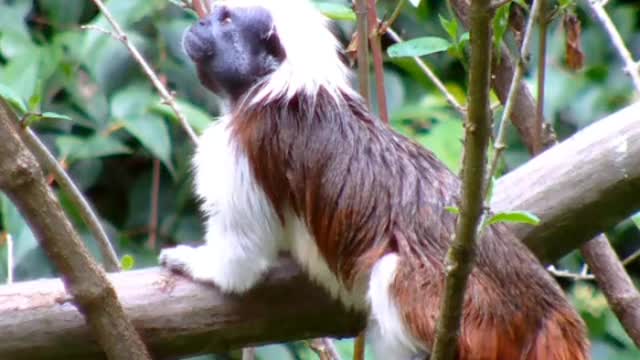Premium Only Content

Cotton top tamarin.
The tamarins are squirrel-sized New World monkeys from the family Callitrichidae in the genus Saguinus. They are the first offshoot in the Callitrichidae tree, and therefore are the sister group of a clade formed by the lion tamarins, Goeldi's monkeys and marmosets.[3]
Tamarins[1][2]Emperor tamarin (Saguinus imperator)Scientific classificationKingdom:AnimaliaPhylum:ChordataClass:MammaliaOrder:PrimatesSuborder:HaplorhiniInfraorder:SimiiformesFamily:CallitrichidaeGenus:Saguinus
Hoffmannsegg, 1807Type speciesSaguinus ursulus
Hoffmannsegg, 1807
Species
22 species, see text
Synonyms
Hapanella Gray, 1870
Marikina Lesson, 1840
Midas E. Geoffroy, 1812
Mystax Gray, 1870
Oedipomidus Reichenbach, 1862
Oedipus Lesson, 1840
Seniocebus Gray, 1870
Tamarin Gray, 1870
Contents
Taxonomy and evolutionary historyEdit
Hershkovitz (1977) recognised ten species in the genus Saguinus, further divided into 33 morphotypes based on facial pelage.[4] A later classification into two clades was based on variations in dental measurements.[5] A taxonomic review (Rylands et al., 2016) showed the tamarins are a sister group to all other callitrichids, branching off 15–13 million years ago. Within this clade, six species groups are historically recognised, nigricollis, mystax, midas, inustus, bicolor and oedipus, five of which were shown to be valid with Sanguinus inustus placed within the midas group. The review noted that the smaller-bodied nigricollis group began diverging 11–8 million years ago, leading the authors to move them to a separate genus, Leontocebus (saddle-back tamarins).[6][7] While a 2018 study proposed that Leontocebus does not have sufficient enough divergence from Saguinus to be in its own genus, and thus should be reclassified it as a subgenus of Saguinus, this proposal has since found significant traction.[8] The same study found the mystax group of tamarins to be distinct enough to be classified in the subgenus Tamarinus.[3] As of 2021 this proposal has not been universally accepted by primatologists.[9]
Taxonomic classificationEdit
Following the taxonomic review of tamarins by Rylands et al. (2016) and Garbino & Martins-Junior (2018), there are 22 species in the genus Saguinus with 19 subspecies.[6][3][10]
Genus Saguinus
Subgenus Saguinus Hoffmannsegg, 1807
S. midas group
Golden-handed tamarin, midas tamarin, or red-handed tamarin, Saguinus midas
Western black-handed tamarin or black tamarin, Saguinus niger
Eastern black-handed tamarin, Saguinus ursulus[11]
S. bicolor group
Pied tamarin, Saguinus bicolor
Martins's tamarin, Saguinus martinsi
Martins's bare-face tamarin, Saguinus martinsi martinsi
Ochraceus bare-face tamarin, Saguinus martinsi ochraceus
S. oedipus group
Cotton-top tamarin or Pinché tamarin, Saguinus oedipus
Geoffroy's tamarin, Saguinus geoffroyi
White-footed tamarin, Saguinus leucopus
Subgenus Tamarinus Trouessart, 1904
Moustached tamarin, Saguinus mystax
Spix's moustached tamarin, Saguinus mystax mystax
Red-capped tamarin, Saguinus mystax pileatus
White-rump moustached tamarin, Saguinus mystax pluto
White-lipped tamarin, Saguinus labiatus
Geoffroy's red-bellied tamarin, Saguinus labiatus labiatus
Thomas's red-bellied tamarin, Saguinus labiatus labiatus
Gray's red-bellied tamarin, Saguinus labiatus labiatus
Emperor tamarin, Saguinus imperator
Black-chinned emperor tamarin, Saguinus imperator imperator
Bearded emperor tamarin, Saguinus imperator subgrisescens
Mottle-faced tamarin, Saguinus inustus
DescriptionEdit
Tamarin species vary considerably in appearance, ranging from nearly all black through mixtures of black, brown and white. Mustache-like facial hairs are typical for many species. Their body size ranges from 13 to 30 cm (5.1 to 11.8 in) (plus a 25-to-44 cm-long (9.8-to-17.3 in) tail). They weigh from 348 to 575 grams (12.3 to 20.3 oz).[12] In captivity, red-bellied tamarins have been recorded living up to 20.5 years,[13] while cotton-top tamarins can live up to 23 years old.[14]
DistributionEdit
Tamarins range from southern Central America through central South America, where they are found in northwestern Colombia, the Amazon basin, and the Guianas.[4]
Behavior and reproductionEditLearn more
This section does not cite any sources. (August 2017)
Tamarins are inhabitants of tropical rainforests and open forest areas. They are diurnal and arboreal, and run and jump quickly through the trees. Tamarins live together in groups of up to 40 members consisting of one or more families. More frequently, though, groups are composed of just three to nine members.
Tamarins are omnivores, eating fruits and other plant parts as well as spiders, insects, small vertebrates and bird eggs.
Gestation is typically 140 days, and births are normally twins. The adult males, subadults, and juveniles in the group assist with caring for the young, bringing them to their mother to nurse. After approximately one month the young begin to eat solid food, although they aren't fully weaned for another two to three months. They reach full maturity in their second year. Tamarins are almost exclusively polyandrous.
Cottontop tamarins (Saguinus oedipus) breed cooperatively in the wild. Cronin, Kurian, and Snowdon tested eight cottontop tamarins in a series of cooperative pulling experiments. Two monkeys were put on opposite sides of a transparent apparatus containing food. Only if both monkeys pulled a handle on their side of the apparatus towards themselves at the same time would food drop down for them to obtain. The results showed that tamarins pulled the handles at a lower rate when alone with the apparatus than when in the presence of a partner. Cronin, Kurian, and Snowdon concluded from this that cottontop tamarins have a good understanding of cooperation. They suggest that cottontop tamarins have developed cooperative behaviour as a cognitive adaptation.[15]
In some locations, saddle-back tamarins (subgenus Leontocebus) live sympatrically with tamarins of the subgenus Sanguinus, but the saddle-back tamarins typically occupy lower strata of the forest than do the Sanguinus species.[16] Saddle-back tamarins have longer and narrower hands than Sanguinus species, possibly adaption to differing foraging behavior, as saddle-back tamarins are more likely to search for insects that are hidden in knotholes, crevices, bromeliad tanks and leaf litter, while Sanguinus species are more likely to forage for insects that are exposed on surfaces such as leaves or branches.[16] This differentiation in lifestyles was why both were formerly considered different genera.[6]
PredatorsEdit
While tamarins spend much of their day foraging, they must be on high alert for aerial and terrestrial predators. Due to their small size compared to other primates, they are an easy target for predatory birds, snakes, and mammals.[17]
ReferencesEdit
^ Groves, C. P. (2005). Wilson, D. E.; Reeder, D. M. (eds.). Mammal Species of the World: A Taxonomic and Geographic Reference(3rd ed.). Baltimore: Johns Hopkins University Press. pp. 133–136. ISBN 0-801-88221-4. OCLC 62265494.
^ Rylands, Anthony B.; Mittermeier, Russell A. (2009). "The Diversity of the New World Primates (Platyrrhini): An Annotated Taxonomy". In Garber, PA; Estrada, A; Bicca-Marques, JC; Heymann, EW; Strier, KB (eds.). South American Primates: Comparative Perspectives in the Study of Behavior, Ecology, and Conservation. Springer. pp. 21–54. ISBN 978-0-387-78704-6.
^ a b c Garbino, Guilherme S.T.; Martins-Junior, Antonio M.G. (2018). "Phenotypic evolution in marmoset and tamarin monkeys (Cebidae, Callitrichinae) and a revised genus-level classification". Molecular Phylogenetics and Evolution. 118: 156–171. doi:10.1016/j.ympev.2017.10.002. PMID 28989098.
^ a b Hershkovitz, Philip (1977). Living New World Monkeys (Platyrrhini): With an Introduction to Primates (1st ed.). University of Chicago Press. ISBN 9780226327884.
^ Natori, M.; Hanihara, T. (1992). "Variations in dental measurements between Saguinus species and their systematic relationships". Folia Primatologica. 58 (2): 84–92. doi:10.1159/000156612. PMID 1612537.
^ a b c Rylands, Anthony B.; Eckhard W. Heymann; Jessica Lynch Alfaro; Janet C. Buckner; Christian Roos; Christian Matauschek; Jean P. Boubli; Ricardo Sampaio; and Russell A. Mittermeier (2016). "Taxonomic Review of the New World Tamarins (Primates: Callitrichidae)" (PDF). Zoological Journal of the Linnean Society. 177 (4): 1003–1028. doi:10.1111/zoj.12386. Retrieved 19 April2020.
^ "Leontocebus". Integrated Taxonomic Information System. Retrieved 19 April 2020.
^ "Leontocebus". ITIS. Retrieved 12 November 2021.
^ "Tamarinus". ITIS. Retrieved 2021-11-12.
^ Database, Mammal Diversity (6 November 2021), Mammal Diversity Database, Zenodo, retrieved 11 November 2021
^ Gregorin, R.; De Vivo, M. (2013). "Revalidation of Saguinus ursula Hoffmannsegg (Primates: Cebidae: Callitrichinae)". Zootaxa. 3721 (2): 172–182. doi:10.11646/zootaxa.3721.2.4.
^ Smith, Richard J.; Jungers, William L. (1997). "Body mass in comparative primatology". Journal of Human Evolution. 32 (6): 523–559. doi:10.1006/jhev.1996.0122. PMID 9210017.
^ Weigl, Richard (2005). Longevity of mammals in captivity; from the Living Collections of the world. Vol. 48. Kleine Senckenberg-Reihe. ISBN 978-3-510-61379-3.
^ Hakeem, A.; Sandoval, R.; Jones, M.; Allman, J. (1996). "Brain and life span in primates". In Birren, J. (ed.). Handbook of the Psychology of Aging. Academic Press. pp. 78–104.
^ Cronin, Katherine A.; Kurian, Aimee V.; Snowdon, Charles T. (2005). "Cooperative problem solving in a cooperatively breeding primate (Saguinus oedipus)". Animal Behaviour. 69 (1): 133–142. doi:10.1016/j.anbehav.2004.02.024. PMC 1483064. PMID 16804561.
^ a b Rylands, Anthony B.; Eckhard W. Heymann; Jessica Lynch Alfaro; Janet C. Buckner; Christian Roos; Christian Matauschek; Jean P. Boubli; Ricardo Sampaio; and Russell A. Mittermeier (2016). "Taxonomic Review of the New World Tamarins (Primates: Callitrichidae)" (PDF). Zoological Journal of the Linnean Society. 177 (4): 1003–1028. doi:10.1111/zoj.12386. Retrieved 19 April2020.
^ Miller, Lynne (2002). Eat or be Eaten. Cambridge University Press. ISBN 978-0-521-01104-4.
-
 3:09:13
3:09:13
Joker Effect
9 hours agoFIRST EVER AMATEUR BOXING EVENT STREAMED ON RUMBLE! BOUGHT TO YOU BY WOLFSDEN BOXING!
54K9 -
 3:33:13
3:33:13
Barry Cunningham
5 hours agoTHE DOGEFATHER & THE DON! HOW ELON MUSK & PRESIDENT TRUMP ARE SAVING AMERICA!
83.5K47 -
 LIVE
LIVE
Phyxicx
5 hours agoGetting ready for $350 tournament! - 5/31/2025
53 watching -
 LIVE
LIVE
Tommy's Podcast
2 hours agoE742: Atomic Piledriver
533 watching -
 3:54:51
3:54:51
Mally_Mouse
12 hours agoSpicy Saturday!! - Let's Play: Group Games w/Friends!
70.8K3 -
 8:11
8:11
Warren Smith - Secret Scholar Society
9 months ago $8.03 earnedThe Professor who Does Not Fear YouTube
38.6K12 -
 LIVE
LIVE
megimu32
2 hours agoSATURDAY NIGHT HANGING + GAMING!! ..who am I?
103 watching -
 26:17
26:17
The Why Files
1 day agoThe Awakening of Human Consciousness | Forbidden Fungus (STRIPPED)
45.8K86 -
 LIVE
LIVE
The Sufari Hub
4 hours ago🔴WE WILL TAKEOVER NIGHTREIGN || ELDEN RING NIGHTREIGN || Ft. KORUPTED
53 watching -
 23:25
23:25
MYLUNCHBREAK CHANNEL PAGE
11 hours agoMilitary Sites STOLE the Old World - Pt 2
82.3K40